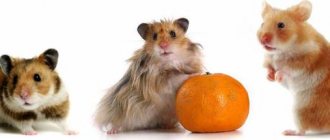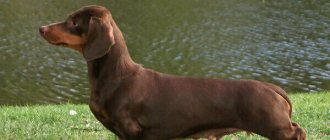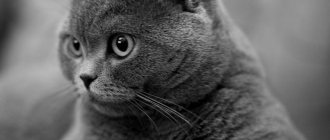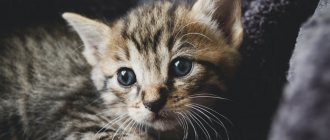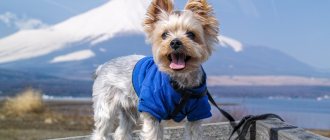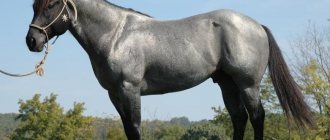Arabian racehorses
The best representative of her type of horse
This is the best representative of her type of horse. Arabian racing horses were exported to all states with powerful horse breeding industries to improve the quality of local breeds. The homeland of these beautiful horses is Dibia and the western banks of the Nile, from where they spread throughout Western Arabia.
The horse's height is not great - from 1,421 to 1,510 mm. Her wide forehead has a convex shape, her large eyes are very expressive, her small ears are very mobile, and her wide nostrils are quite large.
Some important characteristics of the body structure of the Arabian horse are shown in the table:
| Anatomical region | Characteristic |
| Neck | Not swan, but light enough |
| Withers | High |
| Elbow | Muscles are well developed |
| Back | Short |
| Ribs | Cool |
| Groin | Not great |
| Croup | Raised |
| Joints | Well developed, sharply defined |
| Legs | The studs have sharply defined tendons |
| Grandmas | Long and thin |
| Hooves | Solid, cup-shaped |
Most often, horses of this breed are bay (up to 35%) and gray (up to 30%). All the beneficial properties of the breed are perfectly transmitted to the offspring of Arabian racehorses: strength, endurance, low demands and dryness of the body.
Arabian breed.
The Arabian is one of the oldest human-created horse breeds in the world. It is believed that its ancestor was the local horse of the Arabian Peninsula, which was distinguished by its lightness and endurance.
Colors are mostly gray of all shades, bay and red are often found, less often black. With age, gray Arabian horses acquire “buckwheat” - small dark spots on the coat throughout the body. The Arabian horse is the longest-lived among domestic horse breeds. Many of the representatives of this breed live up to 30 years.
English racing horse of Arabian type
The breed was obtained by crossing local horses with several eastern racing breeds.
English racing horses are distinguished by the beauty of their slender forms, dry structure, energy and running speed taken from eastern horses, as well as a massive body and tall stature, for which we should thank the local English horses.
The height of animals is from 1,510 to 1,730 mm. The offspring of the English racehorse fully inherits from their parents all their beneficial properties: tall height, large lung and heart capacity, dense muscles, strong bones, lean build, and the ability to run energetically and quickly.
Special purpose riding breeds
The main types of horses used for riding are divided into the following breeds.
Akhal-Teke
Akhal-Teke horses are the standard of grace, attractiveness and elegance. These animals were known 5 thousand years ago. They owe their name to their place of origin - the state of Akhal-Teke, which was located on the territory of modern Turkmenistan. The need to breed horses was a necessity for local residents, so the owners carefully monitored the living conditions of the animals. The owners did not allow Akhal-Teke horses to be crossed with other horses - thanks to such a reverent attitude, they managed to maintain the purity of the breed. Modern Akhal-Teke horses are practically no different from their ancestors.
Akhal-Teke horses are the standard of grace
Arabic
The Arabian is the oldest breed of horse, which does not lose its value even today. It was these animals that had the maximum influence on the development of other species. Purebred Arabian horses were widespread in the Gulf countries. The breed developed in a hot, arid climate, which affected the character of the animals. These are strong, hardy horses that easily adapt to negative natural factors and retain the ability to reproduce offspring in any conditions.
Thoroughbred
One of the fastest breeds is a thoroughbred horse, bred in England in the 17th century thanks to the crossing of Arabian horses and local horses. They are actively used both in professional equestrian sports and for leisurely walks.
Terskaya
Terskaya was formed in the 20s of the last century by crossing Arabian stallions with Russian breeds (Donskaya, Streltsy, etc.). These are strong, powerful animals that easily adapt to cold climates. Due to their ability to learn, they are used in equestrian sports, horse riding training, and agriculture. They often perform with Terek horses in the circus.
Finnish racing horse, northern forest type
These horses are not only capable of galloping quickly.
These horses are capable of not only galloping quickly, but are also used for various agricultural work. Most often, representatives of the Finnish breed have a red color. Their height ranges from 1,480 to 1,550 mm.
Finnish racing horses are distinguished by a short, thick, well-muscled neck, rounded ribs, and a muscular and wide back. They have slightly drooping rumps, medium-sized heads, and strong and dry legs.
Vyatka racing horse, northern forest type
This breed was obtained by crossing local horses with clopers from Estonia.
Well-knitted Vyatka racehorses are distinguished by their short stature and fast running.
The height at the withers of these horses ranges from 1,460 to 1,550 mm. The suit can be savras or dun. A small head on a muscular neck, a stocky body with a wide chest and a long, thick coat complete the appearance of this powerful horse, which can be used for a variety of jobs where really great effort is required.
Racing Oryol trotter of mixed type
The breed was created by crossing representatives of many other breeds by Orlov.
The breed was created by crossing representatives of many other breeds by Orlov, after whom it was, in fact, named. In Russia, the most popular type is the bushy type of Oryol trotter - large, massive animals with a beautiful head, expressive eyes, a high, beautifully curved neck, a wide chest and strong hooves. Their height ranges from 1,550 to 1,740 mm, and their weight is up to 676 kg.
Oryol trotters are distinguished by the beauty of their running, enormous strength, agility and endurance during heavy work. At the same time, horses have a very gentle disposition.
Classification of horse breeds by nature of use
Riding horse types vary significantly in purpose, external qualities and character traits. They are divided into two types. The first ones are used in professional sports, long-distance races. Such horses are distinguished by their obstinate, stubborn character and recognize only one owner. Unlike “walking” breeds, they need regular strength training.
Horse
The second type is animals that are purchased for personal use, training, and quiet walks. Such breeds are used in the tourism sector. They are characterized by a friendly, calm disposition and easily become attached to people. Some representatives take part in horse racing, showing good results.
Sled
Draft breeds include light draft and heavy draft horses. The former were used for transporting goods and passengers, the latter - in construction and agriculture. Such animals are distinguished by a strong physique, well-developed muscles, and strong limbs. By nature, draft horses are hardy, unpretentious, and remain efficient even in extreme conditions.
Reference. Horse-drawn breeds of horses are universal - they perform well both in hard work and in sports or horse riding. Animals are characterized by high productivity, easily adapt to any type of climate, and rarely get sick.
Mongolian race horse of Mongolian type
The main horse breeding base of the breed is located in the steppes of Inner Mongolia.
The main horse breeding base of the breed is located in the steppes of Inner Mongolia, where there are excellent pastures. These horses are very numerous, numbering approximately 16,000,000 heads.
The size of representatives of this breed is not large. Their height is no more than 1,220 mm. A typical Mongolian horse has a large head, wide forehead, straight neck, large ears, low fleshy withers, wide chest, straight back. The legs of these tough little animals are short, strong, muscular and dry.
Kyrgyz race horse of Mongolian type
The breed is similar to the Mongolian
The breed is similar to the Mongolian, but has some differences:
- Drier scalp.
- Higher at the withers.
- Moderate neck length, dry and light.
- Very hardy.
- Not picky about food.
Although the horse's build looks somewhat rough, it is characterized by agility, energy and high running speed. It absorbs food very well, so in the absence of serious physical activity, against the background of abundant feeding, it can quickly become fat.
What lies behind the popularity of horse breeds?
Different horses were popular in different eras. When people had to cultivate the land by hand and transport heavy loads, they needed strong and durable horses. In this regard, in the 18th century, heavy draft breeds were the most in demand. 100 years later, interest in equestrian competitions appeared in European countries. Horse racing made it possible not only to satisfy the ambitions of the public, but also to earn good money. The need for heavy draft horses has completely disappeared due to the rapid development of technical progress, but the popularity of riding breeds has increased.
Some horses attract attention with their external beauty and temperament, others with their speed and grace. For example, mustangs living on the American continent. These horses are extremely beautiful and popular, but only a person who has managed to tame one can afford to have such a horse.
Belgian walking horse
Large work horse
Large work horse. Its height ranges from 1,550 to 1,650 mm, and its average weight is 800 kg. The Belgian breed can have different colors:
- I'm bay.
- Redhead.
- Roan.
- Voronaya.
- Gray.
These horses are distinguished by their precocity - by the age of two they can perform any work that adult representatives of the breed can do.
Externally, the horse looks very impressive, with a short and thick neck, a muscular back that is not too long, a forked, slightly drooping croup, dry strong legs, with characteristic brushes.
Thanks to its great strength, the Belgian horse can carry heavy loads while remaining very agile. It has good immunity to colds, is not picky in terms of food, but uses its potential to the fullest.
Stepper large Percheron breed
Representatives of this breed are bony, large animals
Representatives of this breed are bony, large animals of gray or black color. Their height at the withers ranges from 1,540 to 1,720 mm. Percherons are distinguished by their enormous strength, mobility and good character.
They have noble heads, prominent wide foreheads, soft ears and lively eyes. A thick mane grows on a long curved neck. The withers are pronounced, the chest is wide, the spine is short, and the hips are powerful and dry. The croup is muscular and wide.
One of the largest horses in the history of the Percheron breed was dr. Le Gear. Its mass was 1,370 kg, and at the withers it reached a height of 2,134 mm.
Horse breeds
Each of all breeds of horses belongs to a certain category according to its purpose, sometimes even in the names of the pedigree the affiliation is indicated: English Saddlebred, Oryol Trotter, Belgian Heavy Draft.
Some breeds have been familiar to people for a long time, but most pedigrees were formed in the 17th–20th centuries. Now about 250 breed lines are known, of which only half are common.
Knowledge of the origins and characteristics of the breeds is important for understanding the purpose of the horse: riding horses are not used for transporting goods, and Percherons are unlikely to win in show jumping competitions. However, there are universal breeds, for example, Friesian horses show the same results both under saddle and in harness. A description of the exterior and temperament gives an understanding of the characteristics of certain pedigrees.
Yakutskaya
Yakut horses are a breed that is not afraid of severe frosts and cold. Horses live in the wild all year round, not experiencing the cold due to their long dense fur, feeding on the remains of frozen grass. The characteristic breed characteristics are:
- large head on a fleshy neck;
- smooth and long back;
- short height - 136–138 cm at the withers;
- thick and warm wool;
- body weight - 500–600 kg;
- strong legs.
Colors of Yakut horses: gray, brown, bay, less often - sauras or mouse.
Percheron
The Percheron breed was formed in France and has the following characteristics:
- head with a prominent forehead, flat nose and long ears;
- neck with a bend;
- extensive chest;
- tight legs;
- short body, wide croup.
The color of Percheron horses is predominantly gray; sometimes black or bullseye horses are found . A distinctive feature of Percherons is a smooth ride with smooth movements.
Trotter Orlovsky
Oryol trotters are powerful, graceful animals, reaching a height of 162–170 cm at the withers. The coat is dense, soft, the body structure is harmonious. The characteristic features of Oryol horses are:
- head with small ears;
- long, smoothly curved neck;
- Arabic profile;
- straight back;
- long legs, sometimes there are brushes on the joints of the hooves.
The color can be gray, bay, nightingale or black; piebald horses are less common. Trotters have a fearless disposition, the animals easily learn commands and are devoted to their owner.
Frisian
Friesian horses are a large breed. These are majestic animals with strong legs that are covered with brushes. The color is considered a feature of the pedigree - purebred Friesians are only charcoal black . Breed characteristics:
- large head with a straight profile;
- neck with a smooth curve;
- height at withers - 165 cm;
- long limbs with developed muscles;
- thick mane and tail.
Pinto
Pinto horses are considered the pride of Americans, and although in fact the animals are not a separate breed, but rather a type of color, breeders treat them with care and attention.
Pinto horses are classified by height:
- miniature - up to 86 cm at the withers;
- pinto pony - up to 142 cm;
- ordinary horses - from 142 cm.
The Pinto is also divided according to purpose into riding, walking, character and hunting types. General features of the Pinto include characteristic spotting. The main colors are black or piebald.
Kazakh
As a result of selection, the Kazakh horse pedigree was divided into two types:
- Adaevskaya - horses reaching 1.45 cm at the withers. Adaevsky Kazakh horses are distinguished by their slender physique, gracefulness and lively disposition. The main colors are white, gold and bay.
- Jabes are short horses that, as a result of crossing with trotters, received an external nobility, but remained persistent and strong. The Jabe reaches a height of 1.4 m at the withers.
Pedigree characteristics of Kazakh horses:
- weight - up to 360 kg;
- large head with low neck;
- rounded, drooping croup;
- short legs.
There are about 300 colors of Kazakh horses, but the most common colors are bay and red.
Altai
The Altai breed is considered a type of draft horse. Representatives of the pedigree combine beautiful appearance and disposition, which makes Altai horses reliable companions and working stallions. Horses grow up to 150 cm in height, weight ranges from 300 to 350 kg.
Exterior Features:
- large head with a straight profile;
- plump, powerful neck;
- straight back;
- the legs are long and widely spaced.
Arabic
The Arabian Thoroughbred is an ancient bloodline that has influenced the formation of many other breeds. Arabian stallions have a special physique:
- there are 17, not 18 ribs in the chest;
- the lumbar region contains 5 rather than 6 vertebrae;
- there are 16 bones in the tail, instead of 18.
Arabian horses reach a height of 150–155 cm, weight ranges from 400 to 600 kg. Characteristics:
- flat back;
- elongated neck with a bend;
- correctly placed legs;
- small head with a “pike” profile;
- long tail, silky mane.
Latvian
Latvian horses are considered to be riding horses and give the impression of being persistent, intelligent and noble animals. The Latvian breed successfully combines the power of its draft ancestors with the elegance of Western pedigrees. Characteristic features:
- large head with a straight profile;
- erect, protruding ears;
- straight back with wide croup;
- muscular thighs.
Among the colors, bay, karak, black and red are common.
Appaloosa
The Appaloosa is an American breed of horse that grows to 1.42–1.55 cm at the withers. Weight varies from 440 to 500 kg. These are typical indicators, but sometimes higher individuals are found. Pedigree characteristics are:
- neat head with pointed ears;
- short back with rounded croup;
- strong legs with durable hooves;
- the tail is set high.
Expressive eyes are considered a distinctive feature of Appaloosas, since the sclera of representatives of this breed is larger than that of others. There are often black spots on the face, and vertical stripes of dark or light color are sometimes found on the hooves.
Karachaevskaya
The Karachay breed belongs to the draft horses, and the North Caucasus is considered its homeland. The height of the animals is 148-152 cm, weight - 800-1000 kg. Externally, Karachay horses are similar to Kabardians. Breed characteristics are considered:
- long mobile ears;
- short neck;
- legs of medium length, correctly spaced.
Karachay horses are unusually hardy animals that move along mountain trails with ease . Representatives of the breed are used in circus performances or for service in mounted police because of their mental abilities, independence and calmness.
Danish horse
Horses of this breed can be used for riding.
Horses of this breed can be used both for riding and for working with a team. These red animals have a height of 1,550 to 1,650 mm. The head is heavy, the forehead is wide, the eyes are large and the ears are long. The neck has a slight bend, the stomach and legs are quite wide.
The pronounced muscles of the legs, coupled with small hooves and wide joints, provide the animal with grace and elegance.
We invite you to join our Zen channel and group on VKontakte or Odnoklassniki, where new articles are published, as well as news for gardeners and livestock breeders.
Similar articles:
- Why can a chinchilla's hair fall out?
- How to make nutria skin: options for at home
- How to breed chinchillas?
